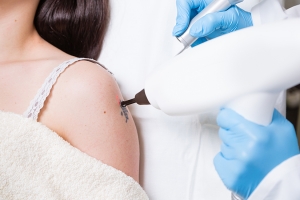Beauty/Appearance Medicine
Tattoo Removal
Tattoo and Body Art
Tattoos and body art are far more sophisticated as more artists are taking their craft seriously. A staggering fact in that Americans spend $1.65 billion annually, and over 45 million of us already have at least one tattoo, Statisticbrain.com reports. Tattoo-removal revenues surged 440% during the past decade, reaching $75.5 million in 2014 and, by 2018, a projected $83.2 million, according to IBISWorld.com.
 According to the American Society for Aesthetic Plastic Surgery (ASAPS), tattoo removal is on the rise and people are paying top dollar to clean up their skin. Tattoo removal procedures reached 45,224 in 2013 in the U.S. compared to 40,801 procedures in 2011. Women are more likely to seek tattoo removal as they accounted for 32,888 (72.7 percent) of procedures. The amount of money paid for tattoo removal treatments also experienced a steep increase, doubling from 2011 to 2013. Depending on the size, color and complexity of the tattoo, removal may require several laser treatments and can run from hundreds of dollars to thousands of dollars.
According to the American Society for Aesthetic Plastic Surgery (ASAPS), tattoo removal is on the rise and people are paying top dollar to clean up their skin. Tattoo removal procedures reached 45,224 in 2013 in the U.S. compared to 40,801 procedures in 2011. Women are more likely to seek tattoo removal as they accounted for 32,888 (72.7 percent) of procedures. The amount of money paid for tattoo removal treatments also experienced a steep increase, doubling from 2011 to 2013. Depending on the size, color and complexity of the tattoo, removal may require several laser treatments and can run from hundreds of dollars to thousands of dollars.
Methods for Tattoo and Body Art Removal
Tattoo ink lives underneath the top layer of skin, which makes it difficult to remove, often requiring multiple laser sessions or in some cases, surgical removal. Laser tattoo and body art removal has become more and more popular as the prevalence of tattoos has increased over recent decades.
The tattoo and body art removal process is a noninvasive procedure that uses a Q-switched laser device to break down the pigment colors of an unwanted tattoo, while causing minimal damage to surrounding tissue. The types of lasers used to remove tattoos and body art are:
• Q-switched Ruby laser
• Q-switched Nd:YAG laser
• Q-switched Alexandrite laser
The rapid absorption of light energy causes the tattoo ink to break into tiny particle remnants that will then be removed by the body’s natural filtering systems. The laser removes the tattoo while damaging the surrounding skin to some degree.
Laser treatment for tattoo removal has improved significantly over the years, making it easier and less painful to remove unwanted tattoos. However, complete tattoo removal can be difficult in many cases, especially for people who have dark skin or multicolored tattoos. The light and heat help remove the tattoo but also create laser wounds. Wound healing will occur over a period of weeks.
NeoGenesis for Healing
For any tattoo removal process, treat the skin in the same manner as recommended for a laser treatment. NeoGenesis Recovery, our most advanced product with abundant S²RM®, should be used twice daily to speed healing, reduce inflammation, irritation and downtime. In addition, our Intensive Moisturizer is to be used twice daily, or as often as needed, to hydrate the skin and provide proper barrier function.
Two weeks after a procedure when significant healing has occurred, Recovery may be reduced to a maintenance application once per day. Continue to use Intensive Moisturizer as needed to maintain the barrier of the skin. Follow this protocol until complete healing has been achieved.


